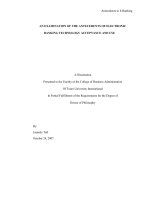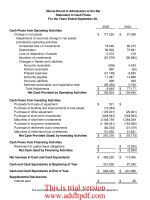Examination of the spleen
Bạn đang xem bản rút gọn của tài liệu. Xem và tải ngay bản đầy đủ của tài liệu tại đây (69.84 KB, 4 trang )
Examination of the Spleen
Wash your hands & Introduce the exam to your patient
Positioning & Draping
• Position the patient so that their abdominal muscles are relaxed.
Therefore, the patient:
o is lying flat
o has arms at their sides
o has a pillow
• Drape so that the abdomen is visible from the nipples to at least
the Anterior Superior Iliac Spines (ASIS’s)
Inspection
• Look for:
• masses, scars, and lesions (trauma)
• atrophy/hypertrophy
• discolouration
• swelling
• muscle bulk/symmetry
• distended abdomen
• Splenomegaly -a bulging mass may be seen emerging from
under the Left costal margin extending
diagonally towards the Right Lower Quadrant
(RLQ)
Percussion (3 methods):
• Percussion of Traube's Space
o boundaries -Left anterior axillary line, 6th rib, costal margin
(see Figure 1)
o this area should be resonant on percussion
o dullness indicates possible splenic enlargement
1
© Michael Colapinto
• Percussion by Castell’s method
o percuss in the lowest Left intercostal space in the anterior
axillary line (usually the 8th or 9th IC space –see Figure 1)
o this space should remain resonant during full inspiration
o dullness on full inspiration indicates possible splenic
enlargement (a positive Castell’s sign)
Figure 1:
The Landmarks for Traube’s Space and the area to
percuss to elicit Castell’s sign
• Percussion by Nixon’s method (optional) (see Figure 2)
o place the patient in Right lateral decubitus
o begin percussion midway along the Left costal margin
o proceed in a line perpendicular to the Left costal margin
o if the upper limit of dullness extends >8 cm above the Left
costal margin, this indicates possible splenomegaly
2
Figure 2:
The landmarks used in Nixon’s Method
Palpation (4 methods)
• Method #1
o begin palpation in the RLQ
o direct the patient's breathing by telling them when to take a
deep breath and when to exhale
o while proceeding diagonally towards the Left Upper Quadrant
(LUQ), try to palpate the spleen edge during each inspiratory
phase
• Method #2
o place your Left hand under patient’s Left posterior chest at pull
upwards
o with your Right hand, begin palpation in the RLQ
o direct the patient's breathing by telling them when to take a
deep breath and when to exhale
o while proceeding diagonally towards the LUQ, try to palpate the
spleen edge during each inspiratory phase
3
• Method #3
o place the patient’s Left fist under their Left posterior chest
o with your Right hand, begin palpation in the RLQ
o direct the patient's breathing by telling them when to take a
deep breath and when to exhale
o while proceeding diagonally towards the LUQ, try to palpate the
spleen edge during each inspiratory phase
• Method #4 –The Hooking maneuver of Middleton (optional)
o place the patient’s Left fist under their Left posterior chest
o position yourself on the patient’s Left side, facing the patient’s
feet
o using both hands, curl your fingers under the patient’s Left
costal margin
o ask the patient to take a long, deep breath à attempt to
palpate the spleen with your fingertips
4









